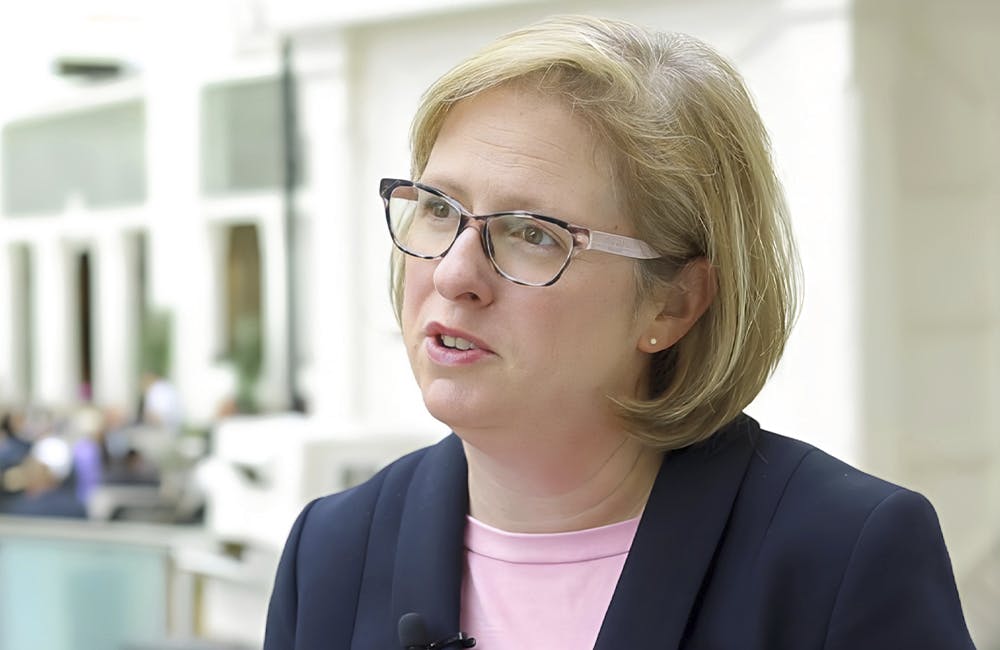Federal Agencies Report Workforce Diversity Improvements
Federal agencies executing DEIA strategies in support of White House executive order 14035 reported improved morale and detailed plans to bolster workforce recruitment.

Federal agencies are reporting significant improvements in diversity, equity, inclusion and accessibility (DEIA) across the federal workforce following a call from the White House in 2021.
Projected by the U.S. Census Bureau, the nation will become “minority white” in 2045; however, in 2018, 93% of the federal government were White, and 80% of them were men. In June 2021, President Joe Biden called on federal agencies to create a workforce that reflects the diversity of the American people.
The June 2021 Executive Order 14035 on Diversity, Equity, Inclusion and Accessibility, required agencies to create strategic plans that identify milestones, goals, actions and potential barriers to advance DEIA. Agencies collaborated with the Office of Personnel Management’s (OPM) DEIA Initiative Team to discuss a three-pronged strategy across a 270-day timeline:
- 100 Days: Agencies submitted DEIA self-assessments
- 150 Days: White House issued the DEIA governmentwide strategic plan
- 270 Days: Initiative team collected agency DEIA strategic plans
Since agencies submitted their strategic plans, they’ve been working on implementation and measuring improvements.
Securities and Exchange Commission
In Dec. 2022, the Government Accountability Office (GAO) conducted a study examining the Securities and Exchange Commission (SEC) employees’ views of personnel management, practices and diversity and inclusion efforts.
“We surveyed SEC employees on their views of SEC’s personnel management practices. Since 2013, when we first reported on this topic, employees’ views on morale and other issues have improved,” GAO reported. “Employees also have favorable views of SEC’s efforts to ensure a diverse and inclusive workforce. But SEC’s strategy for doing so doesn’t include a way to measure its progress—which is necessary in ensuring it meets its goals.”
SEC released its first diversity and inclusion strategic plan in 2020, covering fiscal years 2020 to 2022. Since then, the agency has initiated several new diversity and inclusion efforts, including a professional development program for minority leaders at the agency.
“Building upon earlier efforts, we have made progress with respect to diversity and representation among our senior management, advisory committees, and our Commissioners. We continue to implement our first-ever Diversity and Inclusion Strategic Plan, which the SEC published in 2020. In the near future, we will begin the planning process for the next Diversity and Inclusion Strategic Plan for fiscal years 2023-2025,” SEC Chair Gary Gensler said during his Sept. 2022 opening remarks to the Institute for Inclusion in the Legal Profession.
According to GAO’s 2022 report, 51% of SEC employees reported employee morale is generally high most of the time, compared to only 31% in 2013, showing significant improvement.
Despite the progress, SEC’s 2020 to 2022 strategic plan did not outline performance measures related to the goals in the plan. GAO recommended SEC’s upcoming strategic plan should detail performance measures that align with goals and are clear, measurable, objective and reliable to better track its progress in achieving diversity and inclusion goals and objectives.
As part of the executive order, agencies are charged with taking a data-driven approach to measure progress.
“In the near future, we will begin the planning process for the next Diversity and Inclusion Strategic Plan for fiscal years 2023-2025,” Gensler added. “We want to make sure that career opportunities like internships are accessible for all.”
Department of Veterans Affairs
The Department of Veterans Affairs thoroughly examined how it does business to identify and address implicit bias and barriers in its work, including hiring and retention practices.
As a result of these department-wide analyses, VA plans on implementing several steps designed to address bias against minority applicants and senior executives, including training for hiring managers, better outreach to minority communities and more.
Aligning with executive order 14035, VA launched its Inclusion, Diversity, Equity and Accessibility (I-DEA) strategic plan, which identifies efforts the agency is taking to strengthen its workforce.
The plan features 10 workforce priorities to retain talent and expand diversity, including working with Congress to invest in wages, maximizing bonuses and retention incentives, increasing opportunities to advance, expediting the hiring process, offering greater workplace flexibility, helping cover the cost of childcare, investing in measures to improve employee well-being, investing in education, embedding DEI&A principles and protecting the workforce from COVID-19.
Veterans Health Administration’s Chief Officer for Workforce Management & Consulting David Perry told GovCIO Media & Research the agency leads targeted recruitment campaigns with minority serving institutions such as historically black colleges and universities (HBCU), the National Hispanic Medical Association, the Asian Pacific American Medical Institute Association and more to improve diversity across the agency.
“Our minority race categories are actually about 44% of our workforce, which is about 10% higher than what we see when we look at our similar occupations,” Perry said. “We are absolutely committed to hiring staff that reflect the diversity of America and ensuring that our employees feel included and supported.”
To measure success, VHA is collecting feedback from stakeholders and employees through surveys, listening sessions and open forums. Data management also plays a hand in measuring success as well as providing employees with insights into their careers. VHA uses the relevant civilian labor workforce statistics to measure progress with other federal agencies.
“How do we conceptualize having all this great data and all these great tools for employees to interact with that? What does that look like going forward? It’s really finding a balance between you know what is available from out of the box and what we need from like how our business operates and finding a harmonizing balance between those two,” Perry said.
Perry is also investigating how technology can support VHA’s workforce and improve employee satisfaction. VHA is modernizing its HR systems to create an integrated view of employees’ profiles, what Perry calls the “single pane of glass concept.”
“We’re looking at things that we can streamline so employees know how to access the benefits, they have ability to make changes to their benefits, getting away from all the manual processing… We are a large agency, so there’s inherent bureaucracy that’s in play, but that doesn’t mean that we must live by those old, antiquated ways of doing things. That’s a real focus and concerted effort around how we can make it easier for employees.”
Department of Health and Human Services
The Department of Health and Human Services (HHS) released an Equity Action Plan in April of 2022 to advance health equity in a department-wide effort. HHS is also looking internally to foster a federal workforce reflecting the full diversity of the American people.
“HHS promotes Equal Employment Opportunity (EEO), diversity, equity, inclusion, and accessibility to encourage a climate of innovation and success that capitalizes on the diversity and professionalism of the HHS workforce,” HHS Secretary Xavier Becerra wrote in a statement. “As one of the largest federal agencies, HHS must be a leader in treating employees with dignity and respect.”
HHS’s 2022-2026 strategic plan set an objective to build and sustain a strong workforce through improved recruitment, hiring and retention efforts. As part of this effort, HHS plans to develop and implement a DEIA Strategic Plan.
HHS and its components also invest in career development opportunities to foster the next generation of public servants.
The National Institutes of Health (NIH) established the UNITE initiative in 2021 to identify and address structural racism within the NIH-supported and greater scientific community. UNITE aims to reduce barriers to racial equity in the biomedical research workforce and promote an equitable and civil culture. The initiative acts as a think tank and facilitates research, recommendations and strategy implementation to increase inclusivity and diversity in science.
The Office of Minority Health (OMH) runs a Minority Leaders Development Program. This two-year fellowship provides training to early-career individuals interested in working at HHS to address the social determinants of health and advance health equity. The curriculum focuses on health care policy, leadership skill-building, and cultural competence.
The Centers for Medicare and Medicaid Services’ (CMS) CyberVets program is a six-month educational rotation for transitioning military members. CyberVets trains service members who are interested in starting a career in federal cybersecurity with little or no prior cybersecurity experience. In the program, service members engage in problem-based training and learn the skills required to protect networks and data.
This is a carousel with manually rotating slides. Use Next and Previous buttons to navigate or jump to a slide with the slide dots
-

A Prepared Workforce is Key to Cyber Resiliency
Strong training strategies and emphasizing cyber hygiene basics enhance security practices at federal agencies.
2m read -

Navy Invests in Additive Manufacturing Workforce to Match Pentagon Strategy
DOD issued its Additive Manufacturing Strategy in 2021 to integrate with the private sector and create agile uses of the technology.
5m read -

Defense Officials: Cyber is a Sport That Needs Strong Teammates
Coast Guard, Marine Corps and Navy officials said they are working on new hiring strategies and partnerships amid evolving threats.
5m read -

How Agencies are Justifying Budget Growth in AI, Zero Trust
IT leaders stressed the importance of understanding user knowledge and needs when prioritizing cybersecurity projects.
3m read









